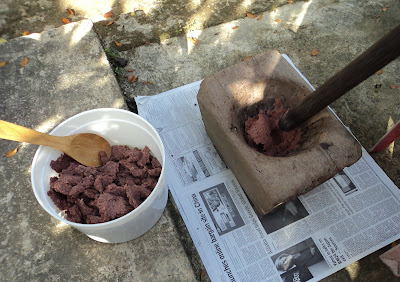Deckson Bundak: What is BUAH DABAI?
Dabai is one of many exotic fruits in Sarawak.
It is commonly known as orkana - means 'black olive' in Hokkien, but technically it is not an olive.
The dabai tree can grow up to 21 meters high and it's furry leaves are thin and its twigs are covered with golden down. A planting distance of 9 meters is recommended. You need to prune the young trees to produce more bushy growth.
 Dabai trees are dioecious (i.e have separate sexes) with male and female trees required for fruiting! Dabai are white in colour when immature and turn black when ripe. They are oblong in shape like an olive and have thin, edible skin. The yellowish white flesh wraps around a three-angled seed. Soak the dabai in hot water until they are soft.
Dabai trees are dioecious (i.e have separate sexes) with male and female trees required for fruiting! Dabai are white in colour when immature and turn black when ripe. They are oblong in shape like an olive and have thin, edible skin. The yellowish white flesh wraps around a three-angled seed. Soak the dabai in hot water until they are soft.
The yellowish flesh tastes creamy. Eating the skin is a personal preference. For taste, try either soy sauce or salt. You can also preserve it just by soaking them with black soy sauce or with coarse salt (without the seed). Dabai fried rice is a specialty dish in Sarawak. However this is a seasonal fruit.
The second best thing that comes out from a fruit is the nut inside the seed. Crack it open with a mortar and pestle set; the good old-fashion way. Use a toothpick to remove the nut if necessary.
 Two things that make Bintulu international. First, from its seas are exported liquefied natural gas. Second, from its coasts ( see inset) are exported the finest and best quality 'Belacan' or shrimp paste. While in Bintulu, this year opening 'Bubuk' or shrimp season have kept me excited to blog about the making of Bintulu belacan. In a year the bubuk season come twice and the next one would normally be in August. What makes Bintulu belacan simply the best? I think it is the waters off its 14 miles of protected natural park beaches stretching from Likau river to Kuala Similajau river. From its blue and unpolluted coastal waters the local fishermen catch the shrimps in nets and these are immediately brought to town to be sold. Another point worth mentioning is the distinct hot and dry weather here that is ideal for the drying process. Ultimately , I think its the legendary skills of the fishing folks here in the fine art of making the belacan as passed from generations to generations with some recipe kept a family secret. In this blog however I'm about to let some secrets out so that you can try your luck with the smell, the sweat and the blisters or else just fork out RM 60 for a kilo of belacan !.
Two things that make Bintulu international. First, from its seas are exported liquefied natural gas. Second, from its coasts ( see inset) are exported the finest and best quality 'Belacan' or shrimp paste. While in Bintulu, this year opening 'Bubuk' or shrimp season have kept me excited to blog about the making of Bintulu belacan. In a year the bubuk season come twice and the next one would normally be in August. What makes Bintulu belacan simply the best? I think it is the waters off its 14 miles of protected natural park beaches stretching from Likau river to Kuala Similajau river. From its blue and unpolluted coastal waters the local fishermen catch the shrimps in nets and these are immediately brought to town to be sold. Another point worth mentioning is the distinct hot and dry weather here that is ideal for the drying process. Ultimately , I think its the legendary skills of the fishing folks here in the fine art of making the belacan as passed from generations to generations with some recipe kept a family secret. In this blog however I'm about to let some secrets out so that you can try your luck with the smell, the sweat and the blisters or else just fork out RM 60 for a kilo of belacan !.  Small fishing boats park nearby the town local market have the shrimps ready packed in ' gantangs'. At the early morning price is inelastic - it's a sellers market. Later in the day when the shrimps are less fresh and the demand less, it's a buyers market. However, when the weather is cloudy or rainy the shrimps can sell much cheaper because there's little sun to help dry them. But then Bintulu's weather is such that when the bubuk season is around there are always days when the sun naturally brings cheer.
Small fishing boats park nearby the town local market have the shrimps ready packed in ' gantangs'. At the early morning price is inelastic - it's a sellers market. Later in the day when the shrimps are less fresh and the demand less, it's a buyers market. However, when the weather is cloudy or rainy the shrimps can sell much cheaper because there's little sun to help dry them. But then Bintulu's weather is such that when the bubuk season is around there are always days when the sun naturally brings cheer.



You need to be a member of Iconada.tv 愛墾 網 to add comments!
Join Iconada.tv 愛墾 網